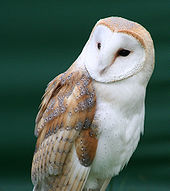 Owls are generally characterized as being birds of prey of the order Strigiformes. Most owls are nocturnal, with a few exceptions. Many owls hunt during the night, while others hunt during the day. While taxonomic classifications of some presumed owl species are still under question, it has been accepted that 216 species of owls exist today, and of these 216 species, 18 belong to the Barn Owl family (Tytonidae) and 198 belong to the typical owl family (Strigidae).
Owls are generally characterized as being birds of prey of the order Strigiformes. Most owls are nocturnal, with a few exceptions. Many owls hunt during the night, while others hunt during the day. While taxonomic classifications of some presumed owl species are still under question, it has been accepted that 216 species of owls exist today, and of these 216 species, 18 belong to the Barn Owl family (Tytonidae) and 198 belong to the typical owl family (Strigidae).
| Barn Owl | Long-eared Owl |
| Barred Owl | Northern Hawk Owl |
| Eagle Owl | Short-eared Owl |
| Elf Owl | Snowy Owl |
| Great Gray Owl | Spectacled Owl |
The distribution of Barn Owls is primarily Australasia (also known as Oceania, which includes New Zealand, Tasmania, Malaysia and many others). Due to its high number of species, the distribution of the typical owl family is widespread, reaching all continents besides Antarctica, and the majority of species reside in the tropics.
